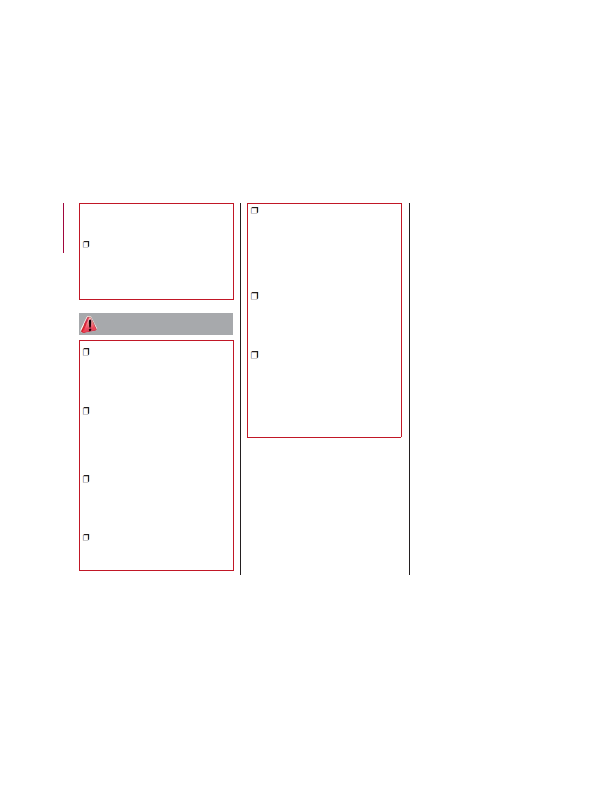
Important Safety- Page 128
2019 Fiat 124 Spider Abarth Owner Manual
Table of Contents

Follow these instructions to wear your seat
belt safely and to keep your passengers
safe, too.
Two people should never be belted into
a single seat belt. People belted together
can crash into one another in a collision,
hurting one another badly. Never use a
lap/shoulder belt or a lap belt for more
than one person, no matter what their size.
Warning!
A lap belt worn too high can increase
the risk of injury in a collision. The seat belt
forces won’t be at the strong hip and
pelvic bones, but across your abdomen.
Always wear the lap part of your seat belt
as low as possible and keep it snug.
A twisted seat belt may not protect you
properly. In a collision, it could even cut
into you. Be sure the seat belt is flat
against your body, without twists. If you
can’t straighten a seat belt in your vehicle,
take it to an authorized dealer immediately
and have it fixed.
A seat belt that is buckled into the
wrong buckle will not protect you properly.
The lap portion could ride too high on your
body, possibly causing internal injuries.
Always buckle your seat belt into the
buckle nearest you.
A seat belt that is too loose will not protect
you properly. In a sudden stop, you could
move too far forward, increasing the possibility
of injury. Wear your seat belt snugly.
A seat belt that is worn under your arm
is dangerous. Your body could strike the
inside surfaces of the vehicle in a collision,
increasing head and neck injury. A seat
belt worn under the arm can cause internal
injuries. Ribs aren’t as strong as shoulder
bones. Wear the seat belt over your
shoulder so that your strongest bones will
take the force in a collision.
A shoulder belt placed behind you will
not protect you from injury during a
collision. You are more likely to hit your
head in a collision if you do not wear your
shoulder belt. The lap and shoulder belt
are meant to be used together.
A frayed or torn seat belt could rip apart
in a collision and leave you with no
protection. Inspect the seat belt system
periodically, checking for cuts, frays, or
loose parts. Damaged parts must be
replaced immediately. Do not disassemble
or modify the seat belt system. Seat belt
assemblies must be replaced after a
collision.
Important Safety
Precautions
Please pay close attention to the
information in this section. It tells you
how to use your restraint system
properly, to keep you and your
passengers as safe as possible.
Here are some simple steps you can
take to minimize the risk of harm from a
deploying air bag:
1. Children 12 years old and under
should always ride buckled up in the
rear seat of a vehicle with a rear seat.
2. A child who is not big enough to
wear the vehicle seat belt properly
(Refer to “Child Restraints” in this
section for further information) must be
secured in the appropriate child
restraint or belt-positioning booster seat
in a rear seating position.
3. If a child from 2 to 12 years old (not
in a rear-facing child restraint) must ride
in the front passenger seat, move the
seat as far back as possible and use
the proper child restraint (Refer to
“Child Restraints” in this section for
further information).
4. Never allow children to slide the
shoulder belt behind them or under
their arm.
5. You should read the instructions
provided with your child restraint to
make sure that you are using it properly.
6. All occupants should always wear
their lap and shoulder belts properly.
126
SAFETY
Detailed Information for 2019 Fiat 124 Spider Abarth Owner Manual
Lists of information found in 2019 Fiat 124 Spider Abarth Owner Manual - Page 128
- 1. Children 12 years old and under should always ride buckled up in the rear seat of a vehicle with a rear seat.
- 2. A child who is not big enough to wear the vehicle seat belt properly (Refer to “Child Restraints” in this section for further information) must be secured in the appropriate child restraint or belt-positioning booster seat in a rear seating position.
- 3. If a child from 2 to 12 years old (not in a rear-facing child restraint) must ride in the front passenger seat, move the seat as far back as possible and use the proper child restraint (Refer to “Child Restraints” in this section for further information).
- 4. Never allow children to slide the shoulder belt behind them or under their arm.
- 5. You should read the instructions provided with your child restraint to make sure that you are using it properly.
- 6. All occupants should always wear their lap and shoulder belts properly.
